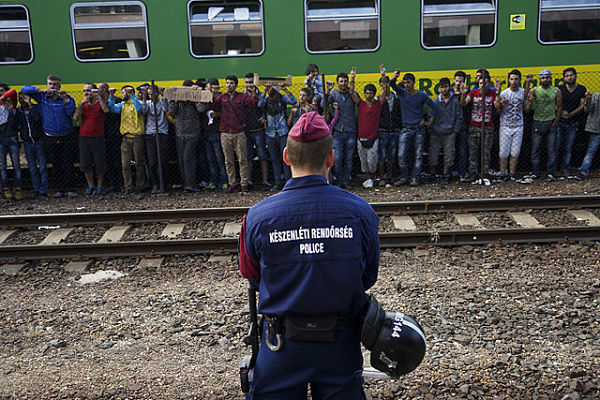 Public Policy
Public Policy How Do Europeans Really Feel About Migrants?

It’s been a year since the group Pegida – an acronym for the German words for Patriotic Europeans Against the Islamization of the West – started railing against immigrants during weekly protests in Dresden. Those protests carried an anti-Islamic cast and were focused on the Turkish “guest workers” in Germany. Pegida saw counter-demonstrations that dwarfed its own rallies, but the group’s stance struck a chord among many in Europe. These fellow travelers saw the Italians facing swarms of Libyans at Lampedusa in the wake of Libya’s civil war and the Spanish fighting a determined front-guard action at Ceuta.
Then came the Syrians (and Iraqis and Libyans et al.) sweeping across Greece, the Balkans and Eastern Europe bound for Northern Europe. Suddenly long peaceful borders started sprouting fences and walls to stem the tide, while anti-immigrants incidents started fill the newshole along reports of politicians using the language of invasion to describe their concerns. “Not just a few hundred or thousand, but hundreds of thousands – indeed, millions – of migrants are besieging the borders of Hungary and Europe,” Hungarian prime minister Viktor Orban cried as be chided Germany “moral imperialism” for turning on a welcoming light for refugees.
Given the angry images cascading off TV screens, it’s pretty clear that migrants aren’t welcome in Europe.
Or are they?
A new themed issue of the International Journal of Comparative Sociology looks at European attitudes toward immigration. It finds, the issue’s editor David A. Smith explains, a nuanced and complicated sets of attitudes toward migrants that Smith admits left him feeling optimistic; “[the papers] debunk some of the simplistic imagery that people have.
“We get the image from watching TV that there’s lots of angry, xenophobic people who don’t want to have the out-groups there. … The data just didn’t show that in any of these articles.”
And while the underlying data collection and analysis in the papers occurred before the current crisis exploded, and when the distinction between ‘migrant’ and ‘refugee’ was less fraught, Smith believes that the larger lessons are likely to have applications both to the present situation and to the flows on migrants elsewhere in the world. “These kinds of papers,” the University of California, Irvine sociologist told Social Science Space, “are not making claims that we can generalize across all time and space, but they are trying to come up with some general patterns.”
“There may not be direct relevance, but the general ideas about attitudes toward in and out-groups – not only is it good social science and applicable to a lot of bigger issues — it’s actually quite relevant to the current situation about different parts of Europe are reacting to the refugees.”
Or as he wrote in an introduction to the issue, “The focus here is not on policy formulation, but good social scientific analysis as a first step toward addressing the real-life challenges that immigration presents to these societies.”
The three papers in the issue tend to flip some common assumptions about attitudes to migrants:
- An examination of self-interest theory by Jens Thomsen and Anders Birkmose who showed that economic vulnerability is strongly related to negative feelings toward immigrants (the out-group) when contact with that group is limited or nonexistent but that disappears when there is intense contact. “In fact,” Smith wrote, “intergroup contact actually lowers anti-immigrant perceptions the most among those who are extremely economically ”
- Using national and regional data from the European Values Survey, Hannes Weber continues on the idea that exposure to immigrants may reduce xenophobia. Contact occurs locally, while debates are usually conducted at a national or even international scale, and Weber shows that “although people living in countries with a high proportion of immigrants view these groups negatively, individuals living in certain regions within nations with a high proportion of immigrants are actually more likely to view immigrants and immigration positively.”
- In the third paper, Kikuko Nagayoshi and Mikael Hjerm looked at policies in welfare states and how citizens, who might see immigrants as free riders, react to migrants. Nagayoshi and Hjerm report that the answer varies based on whether a state opts for ‘active labor market policies’ that focus on improving employability through education and training versus ‘passive’ policies that redirect taxpayer cash directly. “They show,” Smith writes, “that the Europeans who are most likely to harbor strong anti-immigrant feelings are long-term unemployed people passive welfare states, while those in welfare states with active labor market policies are more likely to be supportive of migrants and migration.” The presumption here is that immigrants willing to learn a trade, or adapt their own skills to local norms, aremore deserving of a hand and will ultimately contribute to society.
Building on the “serendipitous” timing of the issue, Smith said it would be interesting to look at the current flow of political refugees. The authors’ data sources don’t easily reveal the different stripes among migrants; “there’s always a tension between interesting questions and what the data tells you.” The real story, he added, will come with mixed methods of investigating, “not just statistical work but getting people in there to talk with these folks.” (Smith added that IJCS has long supported multiple-method work: “We’ve often been focused on big data, but we’re open to research that’s ethnographic.”)
Smith himself made pains to explain that European migration is not his research area.
His own research focuses on urbanization and development, looking at the informal sector in poorer countries and how the international commodity trade to model the international system. In particular, his work has looked at Asia, with examinations of things like watching the movement of manufacturing in the garment industry for countries like Korea and Vietnam.
Asked if migrants, in Europe, in the Southwest U.S., or in Asia, might be looked upon as commodities themselves, he quickly agreed.
“In some ways that’s absolutely true. Labor migration is certainly a big deal, and that’s one of the tensions with what’s going on in Europe right now – there’s a sense that these people are poor and their refugees, and that they just want to take advantage of all these social welfare policies in Europe.
“But we know, and I think it’s pretty clear, that people like Angela Merkel and the Germans have been more liberal is because they have labor shortage. There’s no doubt about it – they have a demographic problem in Germany – and lot of old people and not so many young people – and they need the migrants.” Smith then cited the work of demographer Dowell Myers at USC, who has made similar arguments about younger Latino migrants adding vigor to the economies and demographics of the U.S.
Smith is also the president of the Society for the Study of Social Problems, which raises questions about the role of the academic when confronted with pressing social issues. Smith says he shares the concerns of the advocate on many issues, but in his scholarship “I try and take a Max Weber position – motivated by certain kind of concerns but you try and be objective when doing research. It does seem to me that if you’re trying to bring about progressive change – or even regressive change, I suppose –you’ve got to understand what’s really going on. That’s the first condition of trying to bring about social change.”
































































































